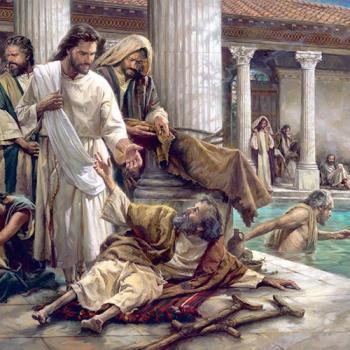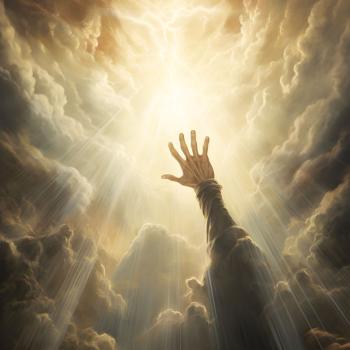Lectionary Reflections
Matthew 25:31-46
November 20, 2011
A friend of mine once worked in a toy factory in Burlington, New Jersey, during the summers when she was in college. Her job (and I am not making this up) was to supervise the making of the farm tops the company produced. The top contained a little farm scene with a barn in the middle, a cow and a sheep on one side and a goat and a pig on the other. Her job was to test the tops to see if they spun evenly. She said the faster she spun the tops, the more the animals blurred together. I couldn't help but think of this parable in picturing my friend on the assembly line spinning the farm top. Sheep/goat, sheep/goat, sheep/goat as the top spun faster and faster they blurred together until she couldn't tell one from the other: geep/shoat, geep/shoat, geep/shoat.
Who is a sheep and who is a goat? We may think we have a clear view of that distinction, and a solid basis on which to judge others, but this parable seeks to disabuse us of that self-righteous notion and turn the spotlight on our own actions.
The three parables that precede this one (The Talents, Bridesmaids, Unfaithful and Faithful Slaves) all stress waiting for and preparing (or not) for the return of Christ. This parable takes listeners forward to the moment the Son of Man comes in glory (v. 31). The nations are assembled and the sheep are separated from the goats (vv. 32-33). This parable is similar to the Rich Man and Lazarus in that the time to repent and be converted, the time to care for the poor on one's doorstep, is past. Judgment has arrived.
The parable emphasizes the connection between seeing a need and acting on it. It is reminiscent of the parable of the Good Samaritan in Luke. The parable says that all three observers of the man in the ditch "saw him." The first two engaged in a twofold action. They "saw him" and then, in response to that sighting, they "passed by on the other side." The response of the third person is threefold. He "saw him," he was "moved with pity," and then he took concrete action to express his compassion and assist the injured man.
The sequence of seeing, having compassion, and acting is a common one in the gospels. In Luke's Gospel, when Jesus "saw" the woman weeping at the death of her only son, he "had compassion for her," and brought her son to life (Lk. 7:13). When the father "saw" the prodigal son "still far off . . . he was filled with compassion" and ran and embraced him (Lk. 15:20). Matthew and Mark repeatedly tell us that Jesus himself, when he "saw" the crowds, had compassion on them and healed, fed, and taught them (Mt. 9:36, 14:14, 15:32; Mk. 6:34, 8:2).
Here in the parable of the Last Judgment what makes some blessed is the fact that, though they didn't realize it, in seeing the poor and helping them, they saw and helped Jesus. By contrast, what makes others cursed is that they never really did see Jesus suffering and in need because they never really saw the poor. The king addresses each of two groups as either blessed or cursed and announces the consequences—enter into the kingdom or depart from him. He states his criterion for making these assignments, a need that they either met or did not meet: "I was hungry, thirsty, a stranger, naked, sick, or in prison and you fed, gave me drink, welcomed me clothes me, visited me, came to see me."
Then the blessed ask the "when" question? "When did we see you hungry, etc. and meet your needs?" The fact that they would question their blessedness tells us something about them. Of course, those who are accursed ask the same question in verse 44, but for a different reason, to attempt to excuse themselves from their punishment. The answer to both the blessed and the accursed group is the same. "Truly I tell you, just as you did it (or did not do it) to one of the least of these who are members of my family, you did it to me" (vv. 40, 45).
The kingdom of heaven shows up where we least expect it. The presence of Jesus is hidden in the sick, the hungry, the thirsty, the naked, and the imprisoned. They are not only the "brothers" of Jesus; Jesus identifies himself with them. As in the Good Samaritan, the one who both saw and acted with compassion was the neighbor to the man in the ditch, so here it is the group that both saw and met the needs of the suffering that is blessed. This is an echo of the Beatitudes in Matthew 5: those who hunger and thirst for righteousness, who are merciful, and who are pure in heart both are and will be blessed.
Paradoxically, blessedness comes from active compassion toward those that society and, in some cases, religion, have judged as accursed. The parable points out that we as individuals, as churches, and as a society, are often not very good at judging others. We are too harsh or we are too lax. We judge by appearances, or we make assumptions about the depths of others' feelings and experiences that are not ours to make. We exclude and we make allowances on other grounds than those set forth in this parable. When we set ourselves up as judge and jury over others, we promote ourselves above our human competence.





